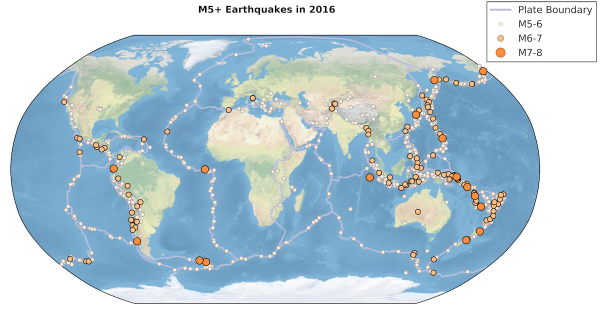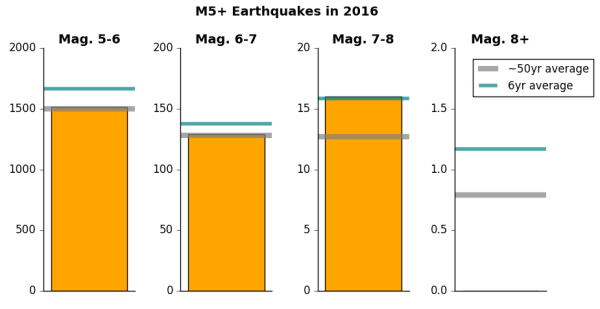![]() Political pundits seem fond of geological metaphors such as ‘earthquake’, ‘seismic shift’, ‘tectonic shift’ and ‘tsunami’ – and they’ve certainly had plenty of reasons to use such metaphors in the past 12 months, as both my birth country and my country of residence decided to flirt with the fact-free side. But what of the planet itself? The Earth’s lithospheric plates continued to jostle against each other in their stately wanderings over the Earth’s surface, producing 1,666 earthquakes of magnitude 5 or greater:
Political pundits seem fond of geological metaphors such as ‘earthquake’, ‘seismic shift’, ‘tectonic shift’ and ‘tsunami’ – and they’ve certainly had plenty of reasons to use such metaphors in the past 12 months, as both my birth country and my country of residence decided to flirt with the fact-free side. But what of the planet itself? The Earth’s lithospheric plates continued to jostle against each other in their stately wanderings over the Earth’s surface, producing 1,666 earthquakes of magnitude 5 or greater:

Global Map of 2016 earthquakes, according to the USGS database.
Of these, 16 – about 1% – were between magnitude 7 and 8; 129 – about 8% – were between magnitude 6 and 7; and the remaining 1521 were between magnitude 5 and 6. There were no earthquakes larger than a magnitude 8 – the largest earthquake in 2016 was a magnitude 7.9 near Papua New Guinea on the 17th December.
Based on our instrumental record of seismic activity since the mid 20th century, in an average year we expect around 1500 magnitude 5-6 earthquakes, around 130 magnitude 6-7 earthquakes, and around 13 magnitude magnitude 7-8 earthquakes. 2016 pretty much hits the average long-term behaviour for M5-6 and M6-7 events on the nose, with a few more M7-8 than the long term average. Even the lack of events larger than magnitude 8 is not particularly unexpected, since there has been less than one of these events a year on average since 1950. That said, it is the first year since 2008, and only the third year since 2000, where we haven’t had an M8 or greater. This relative glut of the largest earthquakes is also reflected in the slightly higher frequency of smaller events averaged over the last six years, since these bigger quakes trigger bursts of (relatively) smaller aftershocks.

2016 earthquake frequency compared to the instrumental record since 1950 (although M5 events are largely missing from the catalogue prior to the 1970s).
Of course, this is not the whole story. It is a long-running theme of my writing about earthquakes that magnitude is not the only thing that matters. Proximity to people, and the kinds of buildings those people live in, can make huge differences in the impact an earthquake has. In 2016, we’ve also seen these factors play out, with large earthquakes that killed a lot of people, just-as-large earthquakes that killed almost nobody (whilst still causing many longer-term problems for people in NZ), and smaller earthquakes that killed a lot of people.
As for 2017, the generalised predictions are easy enough. Around 1500 magnitude 5-6 earthquakes; around 130-150 magnitude 6-7 earthquakes; around 13-15 magnitude 7-8 earthquakes; and possibly one or two magnitude 8 or 9 earthquakes. But again, location matters. Knowing where the biggest earthquakes will occur, and whether those locations will coincide with large numbers of vulnerable people, is currently beyond our capabilities.




Nice plan for content warnings on Mastodon and the Fediverse. Now you need a Mastodon/Fediverse button on this blog.